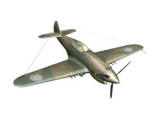
The project that got my foot in
the door for Pacific Fighters, the P-40 stemmed from my fondness for
the lines and history of the early 'smallmouth' P-40 Tomahawks, such as those
flown by the Flying Tigers during their presence in Nationalist China, Burma,
and the other nearby UK eastern colonies. It was a sweet-flying plane, and
has rightful claim to being The Original Shark-mouth Plane--the profile and
contour of the nose and 'mouth' is a dead ringer for an actual open-mouthed 'maneater'
shark (such as tigers, makos, and bull sharks), helping the war paint mesh
psychologically.
Aside from being one of my favorites, the P-40 was also
one of my earliest projects, which meant many, many passes to rework and improve
the overall cut and polish. A crash-prone installation of Max 4.2, of
course, only added to my hair-yanking.
My major learning process with the P-40 was texture
mapping. The IL-2 engine had some very convoluted, poorly documented, and
rarely logical mapping formats and conventions. Learning to squeeze every
last bit of control and functionality out of Max 4.2's archaic UVW mapping
system was the main knowledge I gained from the process. Close behind it
was a far sharper understanding and practical application experience of the
basic theory behind detail and geometry distribution, and a story about a
certain 12-sided 5-inch tail wheel.
The P-40 also began my eternal curse to always land
projects with few to no easily available references. When I began working,
exactly one restored 'smallmouth' existed--in Pensacola, FL. Curtiss, the
company that designed and built the plane, does not exist in the same form (they
now build parts for submarines and hydroelectric plants). Only 200 or so
were built in the first place, before production migrated to the vastly
different 'largemouth' P-40E models. The smallmouth P-40s were used in the
years just before Pearl Harbor and for only a very short time afterwards, so
most pilots who flew them are at the older end of the veteran age spectrum, and
most are gone.
I scoured libraries, scale modeling websites, museums,
and the international kinship of warbird restorationists for anything and
everything. I even came into contact with Chuck Baidsen, who was an
armorer with the Flying Tigers. While I kept searching (and still do,
sometimes) for further references and pictures, I managed to scrape enough
together that by the time I was finished, I truly knew the plane inside and out,
and could not only name every control and instrument in the cockpit, but could
explain what they did and how they worked. I honestly think I could get
one in the air AND back down again, if I had the opportunity.
A day before my deadline, the Seattle Times ran a front
page-and-then-some feature in the Local section on Paul Allen's new Flying
Heritage Collection, which was to open within days, about two hours drive from
where I was living.
Occupying almost the entire front page was the
unmistakable leer of a smallmouth P-40, wearing British Green / Dark Earth
camouflage--and a shark's mouth.
Of course.
Ironically, as of 2008, I still haven't traveled the
two hours to see it.
